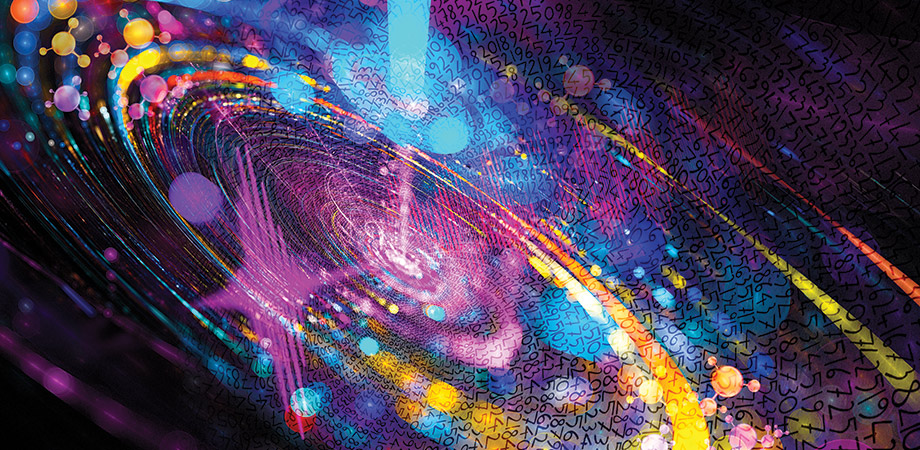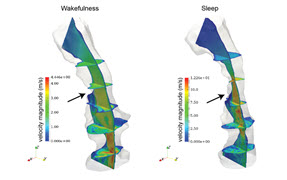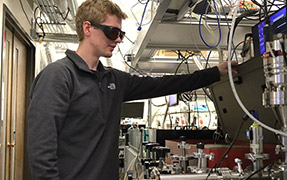Attosecond science: Nobel-worthy nonlinear optics on steroids

We all have moments we wish could last forever: Holding a beloved new baby, a perfect sunset in Mykonos, a professional victory at the top of our game. While it’s not possible to literally stretch time, researchers have succeeded in divvying it up into ever-thinner slices, thanks mainly to lasers. Nanoseconds, picoseconds, femtoseconds—as very short pulses of laser light, these fractions of a fraction of a moment can illuminate otherwise hidden processes in nature as they unfold. It’s not so different from the flash on a camera that can capture and freeze the image of, say, a drop of water in the split second before it touches the surface of a pond.
Femtosecond laser pulses—that is, a pulse duration of one-quadrillionth of a second—have been used in basic research to map, for example, the details of chemical reactions in real time. Because of the precision and high-peak-power of each femtosecond pulse, they have also found both industrial and healthcare applications—like LASIK eye surgery.
Today’s best effort at generating tinier slices of time has yielded the attosecond light pulse, which is fast enough to allow a freeze-frame view of electron behavior or to gain a more precise measurement of the size of an atom. The 2023 Nobel Prize in Physics was awarded to three attosecond light pulse pioneers, Anne L’Huillier (Lund University), Pierre Agostini (The Ohio State University), and Ferenc Krausz (Max Planck Institute of Quantum Optics).
The relationship between one attosecond and one second is like the relationship between one second and the entire age of the Universe. It is, say the scientists who work in this super-speedy realm, a nearly unimaginable timestamp evoked mainly by mode-locked amplified lasers exciting atoms in a vacuum-sealed cloud of gas.
L’Huillier first began to see the possibility of creating attosecond pulses with lasers in the 1990s. From her interest in light-matter interactions, she was focusing infrared (IR) laser light through clouds of gas molecules when she discovered that this would trigger a phenomenon called high harmonic generation (HHG).
To understand HHG, L’Huillier makes this analogy:
“If you run a bow across the string of a violin, you get not only the pure tone—the pure tone frequency—but also other frequencies as well. In music, these are known as overtones. They’re what give the sound its timbre. Overtones are also known as harmonics. Something similar happens when, under specific conditions, you expose a gas to a femtosecond laser pulse.”
The pulse creates new laser frequencies of a much shorter wavelength. “If you will,” L’Huillier says, “high harmonics are the overtones of laser physics.” It’s an analogy she happened upon to explain her work to her son, a professional musician.
HHG has practical applications. It can be used to generate wavelengths of light in the extreme ultraviolet for use in advanced semiconductor metrology, for example.
For basic science, however, L’Huillier soon realized, “if these harmonics could be phase locked, attosecond pulses would be a result.” Still, it took researchers, including Agostini and Krausz, another 14 years of theoretical and experimental work to confirm that this could, in fact, be achieved.
For his part, Agostini and his research group (then in France) succeeded in producing and investigating a series of attosecond light pulses, known as a pulse train. They split their pump laser into two beams, one that would pass through a gas cloud of atoms to generate attosecond pulses. The other part of the beam would be delayed and rejoin the party at a point past creation of the attosecond pulses. Doing so, they could see that each pulse in the train lasted just 250 attoseconds, moving past like train cars.
Krausz and his research group (then in Austria) developed a technique that could isolate a single attosecond pulse. They likened their light-based method to uncoupling a carriage from a train and switching it to another track. The pulse they isolated lasted just 650 attoseconds, and the group used it to track and study how electrons are pulled away from their atoms.
Altogether, these experiments demonstrated that attosecond pulses could be observed and measured, and that they could be used in new experiments. It is now possible to produce pulses down to just a few dozen attoseconds, and the technology continues to develop.
Attosecond pulses can be thought of as a product of nonlinear physics that makes it possible to measure the time it takes for an electron to be yanked away from an atom—a period relative to how tightly the electron is bound to the atom’s nucleus. Moreover, attosecond science makes it possible to reconstruct how the distribution of electrons oscillates from side to side or place to place in molecules and materials, whereas, previously, their positions could only be measured as an average.
Attosecond science remains a basic research tool, but serious speculation abounds about possible future applications, particularly in healthcare. Krausz, for example, sees great promise for attosecond pulses to illuminate biochemical markers in biological fluids like blood, perhaps leading to improved diagnostics for diseases like cancer. And the agencies funding much attosecond science—including, in the US, the Air Force Research Laboratory, Department of Energy, and National Science Foundation—would also suggest wider faith in the benefits of these fundamental investigations.
However far into the future practical applications may be, they will be based on the profound implications of the basic science—impressive all on its own. According to a review paper by Krausz and co-author Misha Ivanov, attosecond technology “entails the ability to control and shape not only the envelopes of the laser pulses but also the sub cycle structure of the field oscillations, extending both measurement and control techniques into the new realm of light-wave engineering and light-wave electronics.”

Postdoc Yaguo Tang (left) and physics professor Lou DiMauro at The Ohio State University examine a laser-beam splitter used for electron experiments. Photo credit: Jodi Miller/The Ohio State University.
For example, attosecond science pioneer Paul Corkum at University of Ottawa uses short IR light pulses beamed across atoms or molecules to generate attosecond soft X-ray pulses. He explains that the intense laser light ionizes the atoms (by knocking off electrons), and it also controls the ionized electrons. It’s like hitting a baseball (the electron), controlling it as it flies away, and then bringing it back to home base (the ion).
These light-controlled electrons produce coherent soft X-ray radiation when the electric field of the laser pulse forces each electron to crash back into the atom from which it left. “This recombination produces the shortest controlled light flashes currently available to science, and they make the fastest measurements that humans can make,” he says. The re-colliding electron wave packet can diffract from its parent molecule, thus imaging the atomic positions, or it can interfere with its parent orbital, providing an orbital image of the electron from which it originated.
Controlling the electron with light, Corkum says, is “fundamental to everything having to do with attoseconds—that you synthesize an attosecond pulse by doing something to the fundamental field so that you control the electron… You put orbital-angular momentum on a fundamental particle, and the orbital-angular momentum gets transferred to the high harmonics. You make it azimuthally polarized, and you can transfer the azimuthal polarization to the higher harmonic. Every aspect of attosecond and high harmonics is transferring information from the infrared, controlling from the infrared, this electron.”
Corkum and L’Huillier say that controlling the electron is a fundamental advance of attoscience. It yields insights on the behavior of the electron, including a direct view of recollision with a nucleus. It is a capability that can tell scientists even more about the nature of a variety of materials.
At The Ohio State University (OSU), where Agostini recently retired, his attosecond science colleague, physics Professor Lou DiMauro, says, “I was always interested in this problem of what happens when an atom interacts with a strong electromagnetic field—specifically, an electromagnetic field comparable to that which binds the valence electrons in the atom.” In that respect, he says, attosecond science is “nonlinear physics on steroids.”
DiMauro heads the Agostini/DiMauro atomic physics group at OSU, which focuses on the development and application of next-generation laser-based attosecond light sources and field-resolved spectroscopic tools to study electron dynamics in atoms, molecules, and solids.
The group uses ultrafast lasers to generate coherent few-cycle light sources, covering terahertz to exahertz regions of the spectrum, and applies them using time-domain optical and photoelectron spectroscopies. The goals are to probe the dynamic electronic structure of materials driven strongly out of equilibrium by an intense laser field, and to investigate the physics of electron wave packet coherence and electron correlation on extreme time scales.
Among the questions attosecond science might address, says DiMauro: What happens to an electron as it’s photo-ionized in a strong electromagnetic field? “When I was a student—and I think we still teach our students this way—in quantum mechanics, you always say that the excitation of an electron in an atom is instantaneous, so don’t worry about it. Well, okay, instantaneous is a relative term, and in fact, we would like to know how instantaneous!”
Most recently, DiMauro was part of an international team that measured attosecond delays in a molecule’s electron activity when it was exposed to an X-ray attosecond pulse. They report that when electrons are ejected by X-rays—photoionization—they interact with another type of particle called the Auger-Meitner electron, causing a secondary pause that’s never been detected before. The results suggest there is much more to learn about light-matter interactions and complex molecular dynamics. DiMauro says X-rays might be used “to take a series of stop-action snapshots of a molecule as it evolves before or during a chemical reaction.”
For their work, DiMauro’s team used the Linac Coherent Light Source (LCLS), a massive free-electron laser at Stanford University’s SLAC National Accelerator Laboratory, because the required X-ray photon energies needed for core-level photoionization are not available with attosecond tabletop sources.
The ability to produce attosecond pulses with X-ray free-electron lasers (XFEL), first reported using LCLS in 2019, has opened a new era in attosecond science. The Stanford XFEL has a pulse energy millions of times larger than any other source of isolated attosecond pulses in the soft X-ray spectral region, with a peak power exceeding 100 GW. That combination of high intensity, high photon energy, and short pulse duration enables the investigation of electron dynamics and single-particle imaging as never before.
More recently, a team at Heriot-Watt University announced they are developing a new laser light source called FASTER (flexible attosecond soliton transients for extreme resolution). Project lead Christan Brahms, in the laboratory of ultrafast physics and optics, that, so far, attosecond science has enabled freeze-frame images of some of the fastest microscopic processes in molecules and materials.
“But it’s limited,” he says. “In nature, these processes involve sunlight, not the wavelengths used in laboratory experiments. My aim is to create laser pulses with similar extremely short duration to conventional attosecond science sources, but at the same ultraviolet and visible wavelengths as we get from the Sun. This will fill in attosecond technology’s blind spots and directly relate our knowledge of ultrafast processes to other areas, like photochemistry or materials science.” He says it will enable scientists to study ultrafast dynamics entirely with nonionizing radiation and without the need for strong-field excitation or probing.
Indeed, newer methods of generating attosecond pulses are bound to spark new ideas about what and how to investigate at the electron scale. “The main challenge of attosecond science,” L’Huillier says, “is that it is still very much basic science. It’s about looking at rapid electron transition using attosecond pulses in complex systems. There is a lot to do.”
William G. Schulz is the Managing Editor of Photonics Focus.



